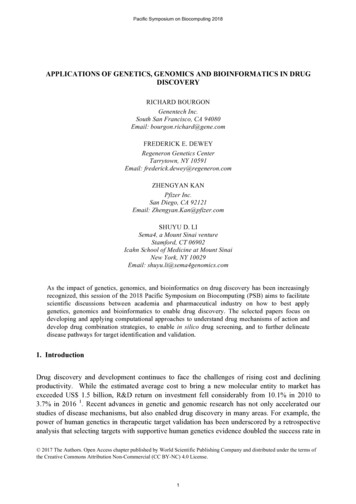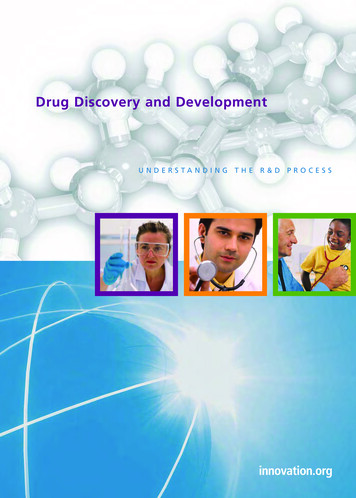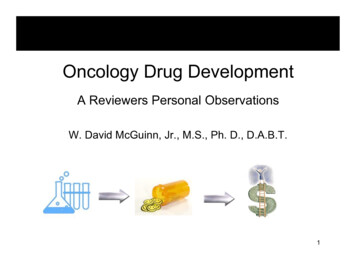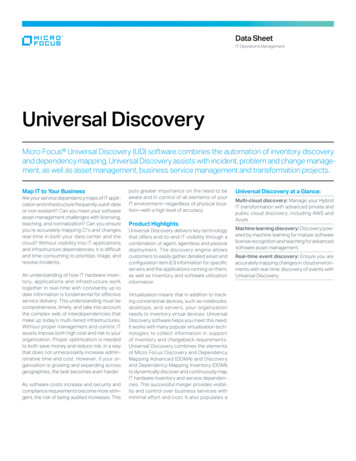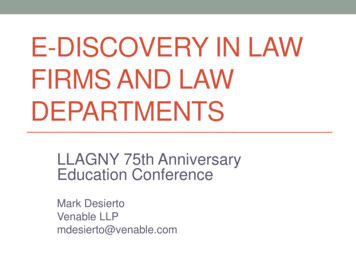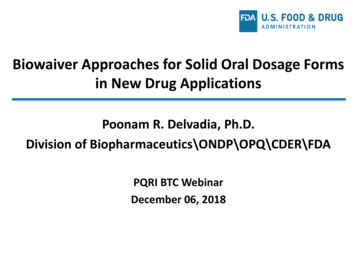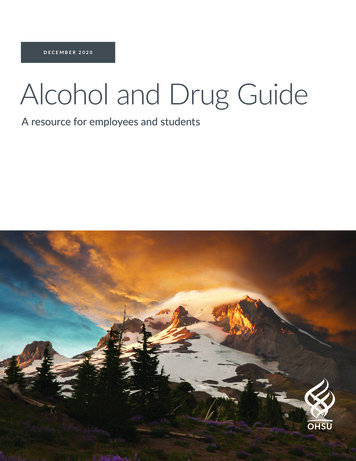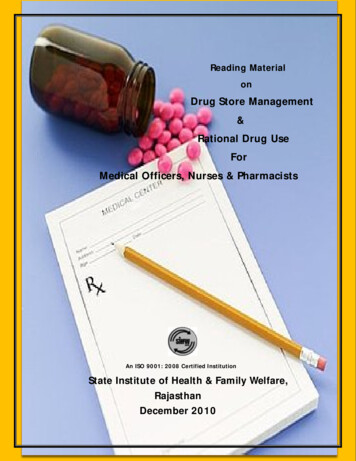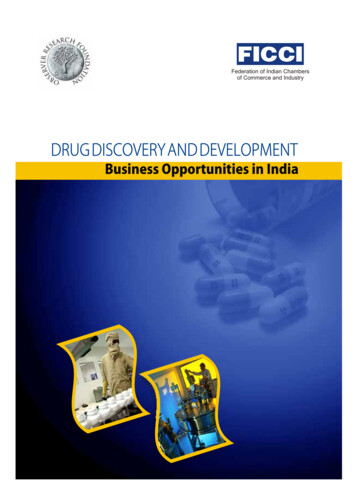
Transcription
Federation of Indian Chambersof Commerce and IndustryDRUG DISCOVERY AND DEVELOPMENTBusiness Opportunities in India
Federation of Indian Chambersof Commerce and IndustryDRUG DISCOVERY AND DEVELOPMENTBusiness Opportunities in IndiaByFalguni Sen1Advisor, Observer Research Foundation, DelhiProfessor, Fordham University, Schools of Business, New York1I would like to thank Bishakha Bhattacharya, Director, FICCI for help with content and editing ofthis report. Support from R K Bhatia, V K Topa and Vivek Sengupta is also acknowledged.
Federation of Indian Chambersof Commerce and IndustryForewordThe sustainability of traditional pharmaceutical Research & Development model isbeing questioned today with changing market dynamics, emerging markets andsaturating growth rates in developed markets. New technological innovations inResearch & Development in the past have been the source of competitive advantage.However today with complex and long development cycles and challenges incomplying with regulatory and quality standards, different business models of Research& Development must be developed, tested and implemented.In fact, a failure to do so may pose a threat to the future of the pharmaceutical industry.Despite such a challenge, advances in technology and innovation process do presentthe industry with opportunities to push forward and prosper. Exploring these futureopportunities to leverage India advantages was at the center of the roundtablediscussion organized jointly by FICCI and ORF on "Drug Discovery-The BusinessOpportunities in India" on March 19, 2009 in Mumbai with the support of Departmentof Pharmaceuticals, Government of India.The full day meeting saw a frank and open discussion in all related issues betweenindustry leaders hailing from pharma, biotech, diagnostic, CROs companies,Government institutions, hospitals and senior government officials from all concernedministries - Department of Pharmaceuticals, Ministry of Health and Family Welfare,Department of Biotechnology. The issues discussed were acknowledged to be critical tomaximize benefit from the business opportunity that Drug Discovery offers.The interest shown by the concerned ministries was indeed heartening, and we arethankful to Shri Ashok Kumar, Secretary Department of Pharmaceuticals, Dr. MK Bhan,Secretary, Department of Biotechnology, Dr. K.K. Tripathi, Senior Advisor, Department ofBiotechnology, Mr. Devendra Chaudhary, Joint Secretary, Department ofPharmaceuticals, Mr. Arun Jha, Joint Secretary, Department of Pharmaceuticals, Mr.Debasish Panda, Joint Secretary, Ministry of Health and Family Welfare andrepresentation from office of DCGI for their presence and insightful comments duringthe deliberations.
Federation of Indian Chambersof Commerce and IndustryWe present this joint FICCI-ORF report based on discussions, to propose a roadmap forboth Industry and Government to consider it as a way forward for the future and longterm sustainability of the Drug Discovery Enterprise.Dr. Falguni SenDr. Amit MitraAdvisor,Secretary General,Observer Research FoundationFICCI
Federation of Indian Chambersof Commerce and IndustryContents1. PURPOSE OF THE REPORT . . . . . . . . . . . . . . . . . . . . . . . . . . . . . . . . . . . . . . . . . . . . . . . . . . . 12. EXECUTIVE SUMMARY . . . . . . . . . . . . . . . . . . . . . . . . . . . . . . . . . . . . . . . . . . . . . . . . . . . . . . 22.1. Vision . . . . . . . . . . . . . . . . . . . . . . . . . . . . . . . . . . . . . . . . . . . . . . . . . . . . . . . . . . . . . . . 32.2. Creating resources to implement vision. . . . . . . . . . . . . . . . . . . . . . . . . . . . . . . . . . . . . 42.3. Creating Networks and Clusters . . . . . . . . . . . . . . . . . . . . . . . . . . . . . . . . . . . . . . . . . . . 52.4. Preclinical . . . . . . . . . . . . . . . . . . . . . . . . . . . . . . . . . . . . . . . . . . . . . . . . . . . . . . . . . . . . 62.5. Clinical . . . . . . . . . . . . . . . . . . . . . . . . . . . . . . . . . . . . . . . . . . . . . . . . . . . . . . . . . . . . . . 72.6. Regulatory . . . . . . . . . . . . . . . . . . . . . . . . . . . . . . . . . . . . . . . . . . . . . . . . . . . . . . . . . . . 93. BACKGROUND SITUATION . . . . . . . . . . . . . . . . . . . . . . . . . . . . . . . . . . . . . . . . . . . . . . . . . . 114. ISSUES AND VIEWS. . . . . . . . . . . . . . . . . . . . . . . . . . . . . . . . . . . . . . . . . . . . . . . . . . . . . . . . 184.1 Creating a "grand strategy" for drug discovery-need for a vision. . . . . . . . . . . . . . . . . 184.2 Generating resources to implement the vision . . . . . . . . . . . . . . . . . . . . . . . . . . . . . . 204.3 Creating networks and clusters . . . . . . . . . . . . . . . . . . . . . . . . . . . . . . . . . . . . . . . . . . 254.4 Pre-clinical . . . . . . . . . . . . . . . . . . . . . . . . . . . . . . . . . . . . . . . . . . . . . . . . . . . . . . . . . . 264.5 Clinical . . . . . . . . . . . . . . . . . . . . . . . . . . . . . . . . . . . . . . . . . . . . . . . . . . . . . . . . . . . . . 284.6 Regulatory issues . . . . . . . . . . . . . . . . . . . . . . . . . . . . . . . . . . . . . . . . . . . . . . . . . . . . . 345. KEY RECOMMENDATIONS . . . . . . . . . . . . . . . . . . . . . . . . . . . . . . . . . . . . . . . . . . . . . . . . . . . 375.1 Vision . . . . . . . . . . . . . . . . . . . . . . . . . . . . . . . . . . . . . . . . . . . . . . . . . . . . . . . . . . . . . . 375.2 Generating Resources to Implement Vision . . . . . . . . . . . . . . . . . . . . . . . . . . . . . . . . . 385.3 Creating Networks and Clusters . . . . . . . . . . . . . . . . . . . . . . . . . . . . . . . . . . . . . . . . . . 395.4 Recruitment and Training . . . . . . . . . . . . . . . . . . . . . . . . . . . . . . . . . . . . . . . . . . . . . . . 395.5 Operations . . . . . . . . . . . . . . . . . . . . . . . . . . . . . . . . . . . . . . . . . . . . . . . . . . . . . . . . . . 405.6 Capacity Building Gaps . . . . . . . . . . . . . . . . . . . . . . . . . . . . . . . . . . . . . . . . . . . . . . . . . 415.7 Pre-clinical . . . . . . . . . . . . . . . . . . . . . . . . . . . . . . . . . . . . . . . . . . . . . . . . . . . . . . . . . . 42
5.8 Clinical . . . . . . . . . . . . . . . . . . . . . . . . . . . . . . . . . . . . . . . . . . . . . . . . . . . . . . . . . . . . . 425.9 Regulatory . . . . . . . . . . . . . . . . . . . . . . . . . . . . . . . . . . . . . . . . . . . . . . . . . . . . . . . . . . 436. ACTION ITEMS . . . . . . . . . . . . . . . . . . . . . . . . . . . . . . . . . . . . . . . . . . . . . . . . . . . . . . . . . . . 457. APPENDIX 1 -PROGRAMME AGENDA. . . . . . . . . . . . . . . . . . . . . . . . . . . . . . . . . . . . . . . . . . 478. APPENDIX 2-- LIST OF PARTICIPANTS . . . . . . . . . . . . . . . . . . . . . . . . . . . . . . . . . . . . . . . . . . 49LIST OF TABLES1. Benefits and Costs of Clinical Trial Enterprise . . . . . . . . . . . . . . . . . . . . . . . . . . . . . . . . . . . 162. Gaps in Drug Discovery Capacity . . . . . . . . . . . . . . . . . . . . . . . . . . . . . . . . . . . . . . . . . . . . . 413. Action Items . . . . . . . . . . . . . . . . . . . . . . . . . . . . . . . . . . . . . . . . . . . . . . . . . . . . . . . . . . . . . 45
Federation of Indian Chambersof Commerce and Industry1. PURPOSE OF THE REPORTThis report provides policy makers with a roadmap to the issues surrounding the "drugdiscovery enterprise" in India, which is edging towards becoming a booming industry. It ismeant to provide perspective, so that future legislative, voluntary or other policy decisionsstrike an appropriate balance between two critical needs: the need for transparency andaccountability of the bio-pharmaceutical research enterprise to advance public health, patientsafety and public trust, and the need to ethically build capacity to enable the sponsors andinvestigators to remain active players in an innovative, sustainable health product industry andhealthcare delivery system.This report is based primarily on an interactive stakeholder workshop hosted in March 2009 asa joint enterprise of the Federation of Indian Chambers of Commerce and Industries (FICCI), theDepartment of Pharmaceuticals, Government of India and the Observer Research Foundation2(ORF) Delhi . Participants representing a wide cross-section of stakeholders including industry,government, medical practice, ethics boards, clinical research organizations, and hospitalsattended. The objective of all the workshops was to discuss and debate the existing provisions,gaps and the policy guidelines that need to be developed and the actions to be taken by thedifferent stakeholders in the drug discovery and development industry to make it grow in anefficient and ethical way. A summary of the main issues and a set of recommendations arebeing included here. This will highlight concerns across the spectrum of stakeholders and willprovide policy makers and other stakeholders with a roadmap of issues to consider infashioning any future approach. The workshops did not vote on the recommendations.However, a number of issues did have broad agreement and are presented here asrecommendations for further action.A common objective guided the stakeholders. The drug discovery and development enterprisein India was seen to help thelPublic: Get well and live longer and more fulfilling liveslFirm: make good returns and sustain profitability to develop products which provide thepublic with its objectivelGovernment: to protect adverse effects and help define "acceptable" risk whileacting as"watchdog" and "partner”2It also draws on two other reports: "Building and Managing Clinical Trial Capacity in India:Challenges in Ethics, Equity and Efficiency" (2006) by Falguni Sen and Vasantha Muthuswamy,and "US-India partnerships in Drug Discovery and Generics" (2008) by Falguni SenDrug Discovery and Development-Business Opportunities in India1
2. EXECUTIVE SUMMARYGlobal transformation of the pharmaceutical industry has given rise to new businessopportunities in drug discovery for India. India has become a preferred location for clinicaltrials. In the last few years there has been a growth in the number of pre-clinical researchcollaborations as well. Indian companies have transitioned effectively from providing a "costand speed" based value proposition in the clinical trials part of the enterprise, and R&D supportservices to the drug discovery enterprise, into more value added areas. From fee for servicemodels, firms have gone into risk sharing and partnerships. From licensing molecules developedin India at early stages they have gone into later stage licensing and are even looking intoproviding end-to-end solutions.There are many stakeholders in the drug discovery and development industry such as theregulatory bodies, public research institutes, universities, hospitals, small biotech companies,specialized R&D firms, domestic pharmaceutical companies, the multinational firms, CROs, thedoctors, the patients, NGOs and the media. Each stakeholder represents different interests andpriorities. However, through it all they have some common objectives: they want the patientsto lead better and fuller lives because of their innovations; they want the firms to makereasonable profits so that they can survive and continue to invest in innovations; and they wantthe government to set the right tone for the industry, act as a watchdog and protect publicinterest while providing the right incentives and partnering with the stakeholders in theindustry.This is a report of a workshop where multiple stakeholders discussed the issues underlying thedrug discovery and development industry with a common goal of making it grow in an ethicalway. The participants recognize the possibility that India can become a major player in theglobal drug discovery and development enterprise. In particular Indian firms could positionthemselves as "leaders" in the emerging bio-similar (follow-on biologics) market where India'sexpertise in innovations and in generics could be combined.There is however, also the recognition of a number of constraints in achieving such a goal. Themain constraint lies in a lack of resources. Sources of high risk funding are not easily accessiblein India. Skills and trained personnel are also in short supply. Assets such as specializedequipment are, unavailable, inaccessible or underutilized and poorly maintained. Indian firmsdo not have a long history of being innovative in this industry and have not as yet been able toshow results. Parts of the industry and the regulatory system are also seen to be working atodds with each other due to historical habits which need changing. There is limited cooperationbetween the public sphere and the private sphere.2Drug Discovery and Development-Business Opportunities in India
Federation of Indian Chambersof Commerce and IndustryThe solution could lie in removing the irrationalities in the system and then leveraging limitedskills and assets to generate higher efficiencies from synergies brought about throughcollaborations and partnerships. This needs to be complemented by generating a nationalinventory of skills and assets to assess shortfalls, and creating a multi-stakeholder governancesystem to optimally allocate resources to fill those gaps. The creation of a networkedorganization (consortiums, clusters etc.) with the appropriate culture of sharing may be the bestcourse of action. New and innovative funding models, which could include the governmentacting as a private equity investor as an option, is necessary to implement the grand strategy.The presence of a strong vision for the drug discovery and development industry is deemed asessential in moving the solution along.Vision, governance and operations can go far but "incentives" are essential to create successfulpartnerships and the culture of genuine sharing. Some incentives such as sharing of intellectualproperty are already in place but more tax incentives for companies and monetary incentivesfor individuals need to be put into place.The government's proactive attitude in trying to energize this industry has been helpful andindustry needs to put together a process and a structure that will facilitate a genuine publicprivate partnership despite the sometimes, different objectives of its various stakeholders.While finer distinctions exist, three broad types of activities may be discerned in the drugdiscovery and development enterprise-the pre-clinical (from lead generation and optimizationto animal toxicological studies), the different stages of clinical trials (from proof of concept andPhase 1 to post market phase 4) and those related to regulatory and intellectual propertyconcerns. This report addresses some of the key issues in each.A summary of recommendations made in the following six areas in this report, is given below.The vision needs to be articulated by the government in collaboration with key stakeholders toprovide the big picture and guide the development of capabilities towards national objectives.Resources need to be generated in innovative ways in order to be able to implement themission. Creating clusters and networks is necessary to provide a system and structure forsharing and generating synergies in order to get the most returns from investments. Preclinicalphase of the drug discovery process has its own needs and specific recommendations relevantto that stage as also the clinical trial stage are identified. Finally, a number of regulatorychanges may be needed and are also summarized.2.1 VisionThe vision needs to be led by the government using a consultative mechanism with the multiplestakeholders such that there is commitment from all and legitimacy to the process. Such avision should:Drug Discovery and Development-Business Opportunities in India3
1. Encourage industry to think big and focus on the first "Indigenously developed Molecule"that gives better therapeutic results in an established category,2. Get the industry to focus on "synergies" and sharing of complementary skills rather than"self sufficiency" by each firm,3. Provide "guidelines" for the development and structure of national and internationalpartnerships and articulate elements of operating procedures to guarantee "sharedlearning",4. Encourage "Industry-Academia" cooperation and provide "status" to industry focusedresearch in academia,5. Encourage industry to develop more trust and cooperation with each other for greatersynergy,6. Incentivize industry to develop an internal culture of "safety" by articulating a "zerotolerance" policy on drug safety and trial subject safety issues and encourage industry tocontinue a culture of efficiency,7. Recognize and communicate to the public the necessary risks associated with moleculedevelopment and trials and articulate a vision for acceptable risk,8. Establish a timeline for India to become a leader in "biosimilars" and articulate specifics onpublic investments in specialized assets to achieve this,9. Declare willingness by the government to "partner" in key investments and create planningand advisory committees to direct a "complementary asset" focused investment wherepublic funds are involved.2.2 Creating resources to implement visionThe drug discovery and development enterprise may require multiple funding models toacquire the resources necessary to implement the vision. There is higher (and a different typeof) risk in this enterprise and government and industry needs to be more entrepreneurial.While it is unfair to ask the government to absorb all the risks in this enterprise without anyrecourse to the returns, there may be ways of creating public-private partnerships that canachieve this. There is however, very little understanding of the ways of making suchpartnerships successful although opinions abound. There is a need to:1. Establish structures and guidelines for public private partnerships where risks and returnscan be appropriately shared,2. Evaluate the different options suggested (private equity, de-merger, licensing, researchcollaboration, public private partnership, and market innovation), by matching each optionwith specific objectives. A committee needs to be formed to assess this,4Drug Discovery and Development-Business Opportunities in India
Federation of Indian Chambersof Commerce and Industry3. Research the success stories of innovative ways of generating such financing/resources, andcommunicate these results through workshops, seminars etc.4. Develop specific guidelines for public private partnerships in the drug discovery anddevelopment enterprise. This should include:a. Structure of such partnershipsb. Risk-reward sharing mechanisms/guidelinesc. Governance structures such as (ownership of shared facilities, board structure, etc.)d. Incentive mechanismse. Sequencing of work such as (public institutions focus on targets and private sector onlead optimization and thereafter)f. Intellectual property5. Work with other departments in the government to develop regulations in finance andother areas that will allow for the ideas suggested above. In particular, investigate thepossibility of a government owned fund that can act as a private equity investment body inthis enterprise,6. Develop mechanisms within industry to articulate high quality projects for help in financing.Such high quality projects need to be consistent with the vision and national priorities setup.2.3 Creating Networks and ClustersClusters need to be created where the entire value chain of the industry is represented. Thiswill facilitate drug discovery. While elements of some clusters need to be physically proximalthere is a way of creating "virtual" clusters to generate the same synergies for some projects.Formalizing "networks" which can act as these clusters can be implemented immediately ifindustry is willing to respond positively to the vision of sharing and complementarities.Some of this can be achieved by:1. A number of firms jointly sponsoring collaborative research with each other and withnational institutes,2. Seconding people from industry into government,3. Government funds be made available for Industry R&D centres4. Providing incentives for industry scientists to do some basic research and academicscientists to do some industry focused researchDrug Discovery and Development-Business Opportunities in India5
5. Conducting industry-academia workshops on research in specific therapeutic areas as wellas technology platforms6. Creating an apex body to facilitate industry government cooperation and help develop anumber of key "communities of practice".2.4. PreclinicalShortage of skilled people and a shortage of animals are two areas in which some immediaterelief may be needed. Streamlining of immigration laws in order to facilitate the acquisition ofglobal talent will speed up the process of skill acquisition. Similarly laws governing the import ofanimals need to be relaxed to address shortages that may exist in the initial period. Ethicscommittees for sites conducting animal toxicological studies should facilitate preclinical animalstudies to advance medicine and science when there are no non-animal alternatives, and whenit is done in an ethical and humane way. Preclinical facilities should comply with GLP and otherinternational standards for their data to be globally acceptable. Schedule Y mentions that"Toxicity studies should comply with the norms of Good Laboratory Practice (GLP)". However,the approvals today are many times granted to studies that have been carried out inlaboratories that may not have GLP. Implementation therefore needs to be strengthened. In theinfrastructure area more capable Phase I facilities are needed as are animal testing facilities.Such facilities need to be accredited for quality and safety. Ability to conduct toxicologyanalysis needs to be enhanced. Primate facilities must be expanded and those in the pipelineimplemented expeditiously. Common services need to be created which will be shared on a feefor service basis. The advantage of ownership of such services by not-for-profit agencies shouldbe investigated.Indian firms need to develop the technological capabilities to select biological platforms andmake more efficient use of bio-informatics. Eventually they must learn to work with lessvalidated targets and develop their own "proof of concept" trials. They must learn to movefrom targets into working with platforms in order to reap the maximum benefits from thediscovery process.Indian firms need to do due diligence on companies conducting pre-clinical tests. Industryshould develop an informal system (like a voting system) to help others identify those firms thatconduct high quality pre-clinical tests and offer integrated services.A number of cultural changes need to be made within the Indian firms if they are to succeed inthe drug discovery process. A culture of discovery must be generated. This includes becomingless risk averse.Good leadership is critical to the success of the drug discovery enterprise in India. Leaders haveto provide the right vision and establish a culture and process where learning from the partners6Drug Discovery and Development-Business Opportunities in India
Federation of Indian Chambersof Commerce and Industrywill indeed take place. An enthusiastic leader with a good vision can be successful in attractinghighly specialized expatriate talent into the firm.The organization must move towards becoming an integrated drug discovery unit with properdocumentation processes and functional and/or therapeutic expertise.2.5 ClinicalSetting up a system of clear-cut priorities for clinical trials can help in providing a balancebetween benefits and risks/costs of the clinical trial enterprise. Such priorities can allocatepublic resources in a manner that meets national interests. For the private sector, prioritiescould mean speedier approvals with a possibility of closer monitoring. It could also meanprivate public partnership in high priority trials.Ethics committees at different levels, ethical guidelines and norms, independent institutionalreview boards are all different ways of ensuring compliance with established ethical guidelinesand good practices. Critical however, is the preparedness of the members of the ethicscommittees to take on this onerous task and actually implement some of the guidelines. Ethicscommittees cannot conduct their task responsibly unless they get the type of data needed toevaluate ethical behavior. Evaluating conflict of interest is an important task of ethicscommittees for which they may need special training and easy access to financial and otherinformation. Cultural specificities in conducting informed consent may place some specialburden in India. Vulnerable populations may need special consideration in the implementationof informed consent. The lack of punitive measures and/or legal liability may reduce theimportance of the findings of the ethics committees.Training of ethics committee members, accreditation of these committees and thedevelopment of more stringent guidelines with detailed operating procedures in response tothe issues raised above needs to be undertaken. Funding for the ethics committee members,distinction between scientific and ethical reviews, operating procedures for implementation ofinformed consent and harmonization of the guidelines and rules between different parts of theregulatory process should be investigated. Vaccine trials may be treated differently in theapproval process.There has been some systematic and some ad-hoc growth in capacity in different parts of theclinical trial process. Much of this growth is taking place without any guidelines and is oftenuncoordinated. The lack of quality control in some of these capacity building measures hascaused public concern. More regulatory capacity to evaluate NDAs and more trained principalinvestigators are needed. There is also a need for more GLP laboratories, an improvedpharmacovigilance program and the ability to monitor GCP sites. The availability of insurancefor subjects of trials is another matter that needs to be urgently addressed.Drug Discovery and Development-Business Opportunities in India7
The creation of a working group to specify the needs for the urgent development of regulatorycapacity in monitoring, oversight, enforcement and approval of trials will be helpful. Aninnovative structure with "consultants" is suggested. A definition of "conflict of interest" in theIndian context for these consultants is also recommended as a task for this working group.Curriculum changes in medical colleges to teach GCP, ethics, and research methodology is alsorecommended. A certification for Principal Investigators is also suggested.Dispute resolution capacity in trials needs to be enhanced at various levels-between subjectsand PIs, and between PIs and regulators. At the present time such resolution mechanisms areunclear and unknown.The creation of a national database on clinical trial capacity in India will help in the planningand resource allocation process and in creating partnerships with synergies between firms. Adatabase of prevalent diseases, therapies and large-scale epidemiological studies will also behelpful.While growth in clinical trials is being fuelled by business opportunities there are several otheroutcomes. Development of world-class expertise in this area is one such outcome. However,care has to be taken to see that knowledge transfer from abroad and local expertise buildingtakes place in a coordinated fashion. Quality control and joint-trials with reputed global playerscan give rise to building expertise in this area. Partnerships between public and private sectorand with international organizations are a great way to increase expertise. It is recommendedthat guidelines be provided to ensure that learning does indeed occur through suchpartnerships. Human resource planning by both industry and regulator needs to be donecarefully to deal with clinical trials of the future (such as molecular diagnostics and molecularepidemiology as well as latest social science techniques) to ensure that required expertise isavailable.The trials registry in place needs to be integrated with the eGovernance sites beingimplemented by government. Simultaneously, there have been great strides in databasemanagement of clinical trials especially in the arena of multi site, multi country trials. Indian ITcompanies are trying to establish a leadership position in these technological platforms. Thegovernment should be proactive in working with ITeS companies to see how this could bestimulated.Media has been criticized for sensationalizing a few cases without investigating systemic issues.Media on the other hand, have complained of lack of transparency on the drug discoveryenterprise. What is the responsible role of the media in reporting issues related to clinicaltrials? It is felt that the media plays a very critical role in locating abuse of the system especiallyin identifying unethical trials and unreported serious adverse events (SAEs). Media should beseen as a partner in this enterprise and has to be provided training to better understand clinical8Drug Discovery and Development-Business Opportunities in India
Federation of Indian Chambersof Commerce and Industrytrials as well as more transparency to do more in depth reporting. It was felt that this wouldincrease public trust in the enterprise that was fast eroding.Public trust is a critical issue for survival and growth in this industry. A few transgressions canerode this trust considerably. Human subjects should be offered the same protections in allactivities such as clinical trials, clinical research, devices, drugs and procedures and all theseshould get formally registered and approved. It is also recommended that a working group beformed to investigate different ways
Drug Discovery and Development-Business Opportunities in India Federation of Indian Chambers of Commerce and Industry. 2 Global transformation of the pharmaceutical industry has given rise to new business opportunities in drug discovery for India. India has become a preferred location for clinical


